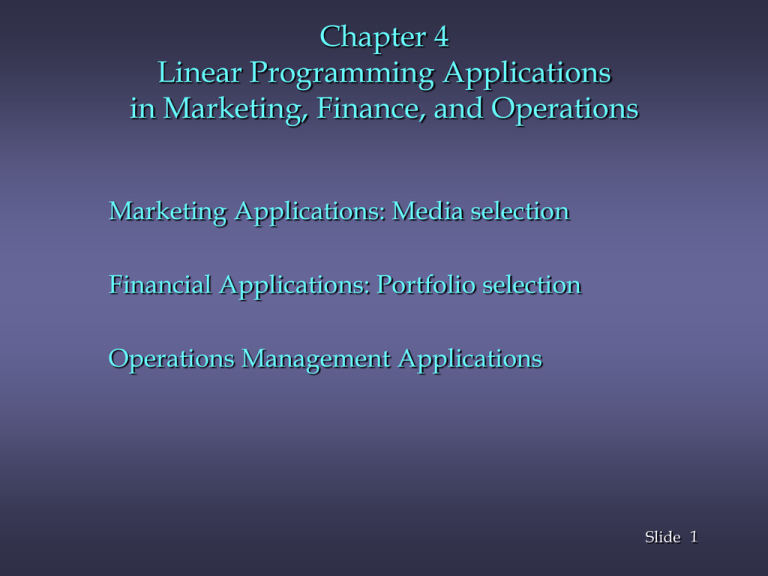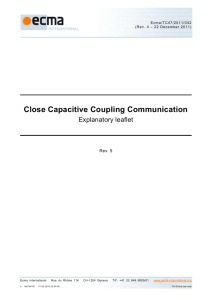Ch4
advertisement

Chapter 4 Linear Programming Applications in Marketing, Finance, and Operations Marketing Applications: Media selection Financial Applications: Portfolio selection Operations Management Applications Slide 1 Marketing Applications Media Selection • One application of linear programming in marketing is media selection. • LP can be used to help marketing managers allocate a fixed budget to various advertising media. • The objective is to maximize reach, frequency, and quality of exposure. • Restrictions on the allowable allocation usually arise during consideration of company policy, contract requirements, and media availability. Slide 2 Marketing Applications: Media Selection The Camden County Chamber of Commerce (CCCC) would like to promote the region to area businesses. Advertising alternatives include television, radio and internet. Estimates of audience reached and costs per advertisement and maximum media usage limitations are shown below: Television Radio Internet Audience/adv. 100,000 18,000 40,000 Cost/adv. $2,000 $300 $600 Maximum usage 10 20 10 To ensure a balance use of advertisement media, television advertisements must not exceed 50% of the total number authorized. In addition, internet ads should account for at least 10% of the total advertisements used. CCCC has a total budget of $18,000. Determine the number of each type of media to use such that the number of audience reached is maximized. If CCCC had an additional $100, what is the net increase of audience reached. Would the allocation of the media stay the same? Slide 3 Media Selection Define the Decision Variables TV = number of television advertisements to use RA = number of radio advertisements to use IN = number of internet advertisements to use Define the Objective Function Slide 4 Media Selection Define the Constraints Slide 5 Financial Applications LP can be used in financial decision-making that involves capital budgeting, make-or-buy, asset allocation, portfolio selection, financial planning, and more. Portfolio selection problems involve choosing specific investments – for example, stocks and bonds – from a variety of investment alternatives. This type of problem is faced by managers of banks, mutual funds, and insurance companies. The objective function usually is maximization of expected return or minimization of risk. Slide 6 Portfolio Selection Willie Maykit, who recently inherited $1,000,000 from his late aunt, would like to invest all his inheritance in a mix of 4 investment instruments, each with characteristics as listed below: Investment Price Annual Return Maximum Risk Type /unit /unit Investment Factor A $60 $3 $500,000 0.7 B $25 $5 $200,000 0.8 C $20 $5 $300,000 1.2 D $40 $8 $250,000 1.4 Due to its low risk, Willie would like to invest at least 30% of the total dollar investments in Type A. Furthermore, he specified that the dollar average weighted risk factor of his investments should not exceed 1.1 Determine the number of units of each investment type to buy so that Willie will maximize his investment returns. How many dollars should Willie invest in each of the 4 types of investments? Slide 7 Portfolio Selection Define the Decision Variables A= B= C= D= Define the Objective Function Slide 8 Portfolio Selection Define the Constraints Total investment amount limited to principal 30% of the total dollar investments in Type A Risk factor of his investments should not exceed 1.1 Slide 9 Portfolio Selection Define the Constraints (continued) Slide 10 Operations Management Applications LP can be used in operations management to aid in decision-making about product mix, production scheduling, staffing, blending, inventory control, capacity planning, and other issues. An important application of LP is multi-period planning such as production scheduling. Usually the objective is to establish an efficient, lowcost production schedule for one or more products over several time periods. Typical constraints include limitations on production capacity, labor capacity, storage space, and more. Slide 11 PRODUCT MIX A MANUFACTURER HAS TWO PRODUCTS, BOTH OF WHICH ARE MADE IN TWO STEPS BY MACHINES 1 AND 2. THE PROCESS TIMES FOR THE TWO PRODUCTS ON THE TWO MACHINES ARE AS FOLLOWS: PRODUCT MACHINE A (hrs). MACHINE B (hrs) 1 4 5 2 5 2 FOR THE COMING PERIOD, MACHINE A HAS 100 HOURS AVAILABLE AND MACHINE B HAS 80 HOURS AVAILABLE. THE PROFIT FOR PRODUCT 1 IS $10 PER UNIT AND PRODUCT 2 IS $5 PER UNIT. DEFINE THE DECISION VARIABLES AND FORMULATE THE LP PROBLEM. Slide 12 PRODUCT MIX Define the Decision Variables Objective Function Constraints Slide 13 PRODUCT MIX A MANUFACTURER HAS TWO PRODUCTS, BOTH OF WHICH ARE CAN BE MADE BY EITHER BY MACHINES 1 AND 2. THE PROCESS TIMES FOR THE TWO PRODUCTS ARE AS FOLLOWS: PRODUCT MACHINE A (hrs). MACHINE B (hrs) 1 4 5 2 5 2 FOR THE COMING PERIOD, MACHINE A HAS 100 HOURS AVAILABLE AND MACHINE B HAS 80 HOURS AVAILABLE. THE PROFIT FOR PRODUCT 1 IS $10 PER UNIT AND PRODUCT 2 IS $5 PER UNIT. DEFINE THE DECISION VARIABLES AND FORMULATE THE LP PROBLEM. Slide 14 PRODUCT MIX Define the Decision Variables Objective Function Constraints Slide 15 Workforce Assignment Due to recent budget cuts, Gotham City Police department would like to better utilize its police force. The minimum required number of police officers for each time period is as follows: Time Period Minimum Patrol Officers Midnight-4 a.m 6 4-8 a.m. 4 8-noon 14 12-4 p.m. 8 4-8 p.m. 12 8-midnight 16 Police officers report for duty at midnight or each of the following 4 hour intervals and they work continuously fir 8 hours. What is the minimum number of officers needed per day? Slide 16 Workforce Assignment Define the Decision Variables Define the Objective Function Slide 17 Workforce Assignment Define the Constraints (continued) Slide 18 Blending Problem BURN-CLEAN OIL COMPANY PRODUCES REGULAR AND PREMIUM GASOLINE. BOTH TYPES OF GASOLINE ARE PRODUCED BY BLENDING TWO TYPES OF CRUDE OILS. THE CRUDE OILS CONTAIN TWO INGREDIENTS, NAMELY A AND B. THE PERCENTAGES OF INGREDIENTS A AND B, AND THE COST PER GALLON OF EACH TYPE OF THE CRUDE OIL ARE AS FOLLOWS: CRUDE OIL COST INGREDIENT A INGREDIENT B 1 $0.20 20% 60% 2 $0.30 50% 30% EACH GALLON OF REGULAR MUST CONTAIN AT LEAST 40% OF INGREDIENT A, AND EACH GALLON OF PREMIUM CAN CONTAIN AT MOST 50% OF INGREDIENT B. THE DAILY DEMAND FOR REGULAR AND PREMIUM GASOLINE ARE 800,000 GALLONS AND 500,000 GALLONS, RESPECTIVELY. FORMULATE THE LP PROBLEM. Slide 19 Blending Problem Define the decision variables Define the objective function Slide 20 Blending Problem Define the constraints Slide 21 MULTIPERIOD PRODUCTION PLANNING MODEL XYZ CO. USES A 3 MONTH PLANNING HORIZON TO PLAN THE PRODUCTION OF WIDGETS. INVENTORY AT THE END OF MARCH IS 500 UNITS. MANAGEMENT WANTS AT LEAST 300 UNITS IN INVENTORY AT THE END OF JUNE. THE INVENTORY HOLDING COST IS $2.00/UNIT/MONTH. PRODUCTION RATE IS 2 UNITS / HOUR. EACH WIDGET REQUIRES 5 SQ FT. AND THE WAREHOUSE STORAGE CAPACITY IS 10,000 SQ FT. USE THE FOLLOWING DATA TO FORMULATE THE LP MODEL TO FIND THE OPTIMAL PRODUCTION SCHEDULE THAT MEETS THE DEMAND. Month Demand Prod cost/unit Prod. capacity April 600 units $ 10 1000 hrs May 1500 15 800 June 2500 15 600 Slide 22 MULTIPERIOD PRODUCTION PLANNING MODEL Define the decision variables Define the objective function Slide 23 MULTIPERIOD PRODUCTION PLANNING MODEL Define the constraints Slide 24








![What_do_Fish_Have_to_Do_with_Anything[1]](http://s3.studylib.net/store/data/006629434_1-a00b1e75dfb71b3f93ad5805d2caa648-300x300.png)

